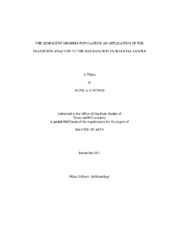| dc.description.abstract | This study uses Transition Analysis on the Mimbres skeletal remains of the NAN Ranch Ruin to provide a more complete picture of its demography. Previous attempts to reconstruct the demographic structure of prehistoric populations have been hindered by aging methods that provide biased age distribution. Early methods had a tendency to produce age distribution similar to that of the reference sample that was used to create them. In addition, they often overlooked sexual dimorphism and left out the senescent portion of the population which in turns produced inaccurate population structures. Transition Analysis is a multifactorial approach to estimate the age-at-death of adult skeletons that focuses on the cranium, the pubic symphysis and the auricular surface of the ilium. The method relies heavily on the Bayesian probability that a given trait or a given combination of traits is displayed at a given age, it recognizes sexual dimorphism, performs well on fragmentary skeletons and allows for the age estimation of older individuals.
The NAN Ranch Ruin sample consists of over 240 individuals, including 185 from the Classic Period. A previous study focused on the 81 individuals from the Classic period that were collected during the first five years of excavations. Following age estimation of adult skeleton I constructed composite abridged life tables. For the Classic Period, I found a high infant mortality rate (47%) and low life expectancy at birth (21.14 years) as expected. However, this analysis produced different mortality patterns than older demographic studies, where mid adult mortality increases only slightly, decreases in late adulthood (40-55 years old) and increases again in senescence (55-80 years old), instead of increasing steadily in adulthood to culminate at age 50. This difference is a consequence of the aging methods that have been used to analyze other southwestern prehistoric samples. Finally, while I was not able to confirm different mortality patterns between males and females, I found that people from the east roomblock enjoyed greater longevity than those from the south roomblock, though the difference is not statistically significant. | en |


